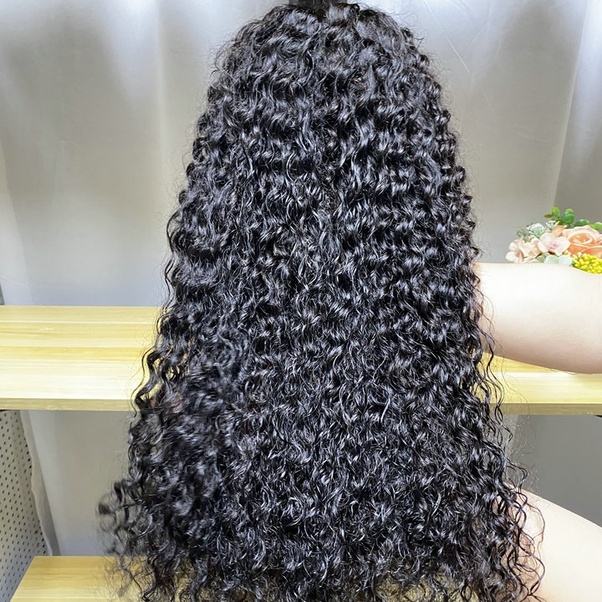Introduction
Keeping synthetic curly hair from frizzing requires a combination of proper care, styling techniques, and the use of suitable products. Frizz can be a common issue for synthetic curly hair due to factors like humidity, friction, and lack of moisture. By following the tips below, you can effectively manage frizz and maintain smooth, defined curls:
Use a Gentle Cleansing Routine:
Start by washing your synthetic curly hair with a sulfate-free, gentle shampoo specifically designed for synthetic hair. Avoid using hot water, as it can strip the hair of its natural oils and contribute to frizz. Instead, opt for lukewarm or cool water to help maintain the integrity of the synthetic fibers.
Condition Regularly:
After shampooing, apply a moisturizing conditioner to your synthetic curly hair to help restore hydration and smooth the hair cuticle. Focus on the mid-lengths and ends, as these areas tend to be drier and more prone to frizz. Leave the conditioner on for a few minutes before rinsing thoroughly with cool water.
Detangle with Care:
Use a wide-tooth comb or a detangling brush to gently remove knots and tangles from your synthetic curly hair. Start from the ends and work your way up to the roots to avoid causing breakage or damage. Apply a leave-in conditioner or detangling spray to help make the process easier.
Avoid Heat Styling:
Synthetic hair is not heat-resistant, so avoid using hot styling tools like flat irons or curling wands on your synthetic curly hair. Excessive heat can damage the fibers and lead to frizz and tangling. Instead, embrace your natural curl pattern or use heat-free styling methods like braiding or twisting to create defined curls.
Apply Anti-Frizz Products:
Invest in anti-frizz products specifically formulated for synthetic hair, such as serums, creams, or oils. These products help smooth the hair cuticle, reduce static electricity, and control frizz throughout the day. Apply a small amount of product to your palms and gently distribute it through your curls, focusing on the areas prone to frizz.
Protect from Humidity:
Humidity can cause synthetic curly hair to frizz and lose definition. To combat this, consider using a humidity-resistant styling product or finishing spray to help seal the hair cuticle and protect against moisture in the air. You can also wear a scarf or hat on humid days to shield your hair from the elements.
Sleep on Silk or Satin:
To prevent friction and frizz while you sleep, switch to a silk or satin pillowcase or invest in a satin hair bonnet or scarf. These smooth fabrics help reduce friction between the hair and the pillow, minimizing frizz and preserving your curls overnight.
Refresh Your Curls:
If your synthetic curly hair starts to look dull or frizzy between washes, consider using a curl refresher spray or a mixture of water and conditioner to revive your curls. Lightly mist the product over your hair and gently scrunch to redefine your curls and add moisture.
Protect from UV Rays:
Exposure to sunlight and UV rays can damage synthetic hair fibers and contribute to frizz. Consider using a UV protectant spray or wearing a hat when spending extended periods outdoors to shield your hair from harmful rays and maintain its vibrancy.
Regular Maintenance:
Finally, schedule regular maintenance appointments to trim any split ends and keep your synthetic curly hair looking its best. Removing damaged ends helps prevent frizz from traveling up the hair shaft and maintains the overall health and appearance of your curls.

Avoid Touching Your Hair:
Constantly touching and playing with your hair can lead to frizz as the natural oils from your hands transfer to the hair strands. Try to resist the temptation to run your hands through your hair throughout the day, as it can disrupt the curl pattern and contribute to frizz.
Minimize Brushing:
Over-brushing or using a brush on synthetic curly hair can cause friction, leading to frizz. Instead, opt for finger-combing or using a wide-tooth comb to detangle your hair. This helps minimize breakage and maintains the natural shape of your curls.
Apply a Leave-In Conditioner:
After washing and conditioning your hair, apply a leave-in conditioner specifically formulated for synthetic hair. Leave-in conditioners provide additional moisture and help prevent frizz by keeping the hair hydrated and nourished.
Avoid Overloading with Products:
While it’s important to use products that provide moisture and control frizz, be mindful not to overload your hair with too many styling products. Excessive product buildup can weigh down the hair and make it appear greasy or dull. Start with a small amount of product and gradually increase if needed.
Opt for Air Drying:
Whenever possible, allow your synthetic curly hair to air dry instead of using heat or a blow dryer. Heat can cause the hair fibers to become frizzy or damaged. If you’re in a hurry, you can use a diffuser attachment on a low heat setting to help speed up the drying process.
Protect Your Hair at Night:
Before going to bed, gently gather your hair into a loose bun or pineapple on top of your head and secure it with a soft hair tie or scrunchie. This helps prevent friction against the pillowcase, reducing frizz and preserving the shape of your curls overnight.

Avoid Harsh Weather Conditions:
Extreme weather conditions like wind, rain, or snow can lead to frizz in synthetic curly hair. Protect your hair by using a hood, hat, or umbrella when venturing out in challenging weather. If your hair does get wet, allow it to dry completely before styling to prevent frizz.
Deep Condition Regularly:
Treat your synthetic curly hair to a deep conditioning treatment once a month or as needed. Deep conditioning helps restore moisture, softness, and elasticity to the hair, reducing frizz and improving overall manageability.
Minimize Exposure to Chlorine and Saltwater:
Chlorine and saltwater can be drying and damaging to synthetic hair, causing it to become frizzy and brittle. If you plan on swimming, protect your hair by wearing a swim cap or thoroughly wetting it with fresh water before entering the pool or ocean. Afterward, rinse your hair with clean water and apply a leave-in conditioner to counteract any potential drying effects.
Experiment with Protective Hairstyles:
Protective hairstyles like braids, twists, or updos can help minimize frizz and maintain the integrity of your synthetic curly hair. These styles keep the hair tucked away, reducing exposure to external elements and friction.

Conclusion
Remember that each person’s hair is unique, and it may take some trial and error to find the best routine and products for your synthetic curly hair. Be patient and gentle with your hair, and don’t be afraid to adjust your routine based on how your hair responds. With proper care and attention, you can enjoy beautiful, frizz-free curls with your synthetic hair.

